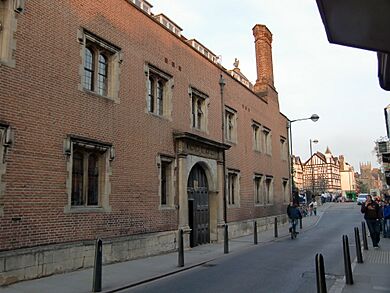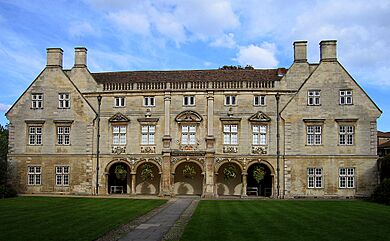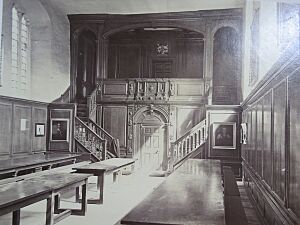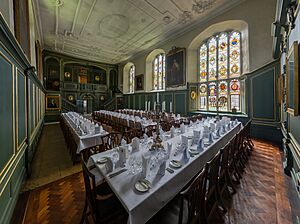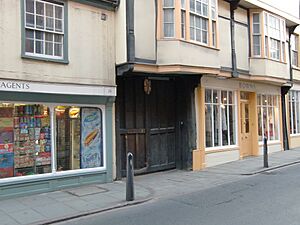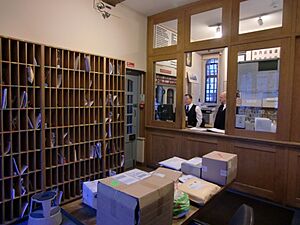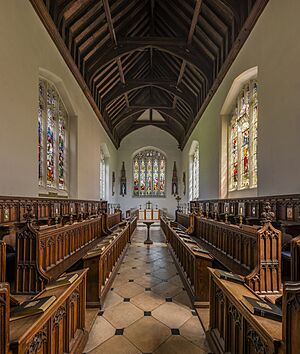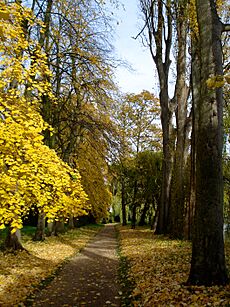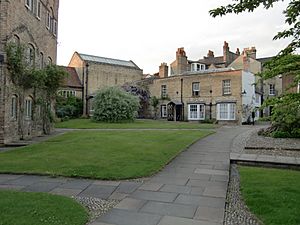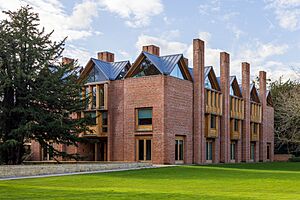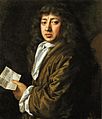Magdalene College, Cambridge facts for kids
Quick facts for kids Magdalene College |
||||||||||||
|---|---|---|---|---|---|---|---|---|---|---|---|---|
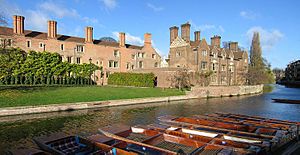
Magdalene College on the River Cam
|
||||||||||||

Arms of Magdalene College, being the arms of Thomas Audley, 1st Baron Audley of Walden. Blazon: Quarterly per pale indented Or and azure, on a bend of the second between in sinister chief and dexter base an eagle displayed a fret between two martlets of the first.
|
||||||||||||
|
|
||||||||||||
| University | University of Cambridge | |||||||||||
| Location | Magdalene Street (map) | |||||||||||
| Full name | The College of Saint Mary Magdalene in the University of Cambridge | |||||||||||
| Latin name | Collegium Sanctae Mariae Magdalenae | |||||||||||
| Abbreviation | M | |||||||||||
| Motto | Garde ta Foy (Old French) | |||||||||||
| Motto in English | Keep your faith | |||||||||||
| Founders |
|
|||||||||||
| Established | 1428 Refounded 1542 |
|||||||||||
| Named after | Mary Magdalene | |||||||||||
| Previous names | Buckingham College (1428–1542) | |||||||||||
| Sister college | Magdalen College, Oxford | |||||||||||
| Master | Sir Christopher Greenwood | |||||||||||
| Undergraduates | 383 (2022-23) | |||||||||||
| Postgraduates | 199 (2022-23) | |||||||||||
| Map | ||||||||||||
| Lua error in Module:Location_map at line 420: attempt to index field 'wikibase' (a nil value). | ||||||||||||
Magdalene College (pronounced MAWD-lin) is one of the colleges that make up the University of Cambridge in England. It started in 1428 as a place for Benedictine monks to stay and study. Back then, it was known as Buckingham College. Later, in 1542, it was re-established and given its current name, the College of St Mary Magdalene.
Magdalene College received help from important people throughout history. These included powerful figures like the Duke of Norfolk and the Duke of Buckingham. Thomas Audley, a top legal advisor to King Henry VIII, was key to the college's new beginning. He also gave the college its motto, garde ta foy, which means "keep your faith" in Old French.
Today, Magdalene is one of the smaller colleges at Cambridge. It has about 400 undergraduate students and 200 graduate students. The college has a strong academic record. It often ranks among the top colleges in the university. Magdalene is also home to the Pepys Library. This library holds a special collection of rare books and writings. They belonged to Samuel Pepys, a famous English diarist who studied at the college.
Contents
College History
Early Days: Buckingham College
Magdalene College began in 1428 as Monk's Hostel. It was a place for student monks from the Benedictine order. The location was chosen carefully. It was separated from the town by the River Cam. It was also protected by Cambridge Castle. The main buildings were constructed in the 1470s. This happened under the guidance of John de Wisbech, who was then the Abbot of Crowland. Later, with support from Henry Stafford, 2nd Duke of Buckingham, the place was renamed Buckingham College.
In the 16th century, the Church of England separated from the Pope. This period was called the English Reformation. Many monasteries were closed during the Dissolution of the Monasteries. Crowland Abbey, which was linked to Buckingham College, was dissolved. However, the college itself continued to operate.
Becoming Magdalene College
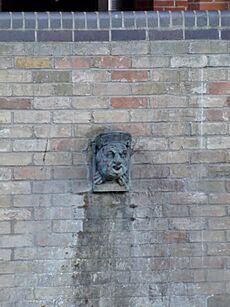
After the monasteries were dissolved, Walden Abbey came into the hands of Thomas Audley. On April 3, 1542, Audley re-established Buckingham College. He renamed it the College of Saint Mary Magdalene. The college's coat of arms, including its motto Garde Ta Foy and the wyvern symbol, came from Audley.
Thomas Audley passed away in 1544, just two years after he re-founded the college. He had given the college seven acres of land in London. This land was a gift from King Henry VIII. It was given to Audley for his role in the downfall of Anne Boleyn. This property could have brought a lot of money to the college. However, in 1574, a banker named Benedict Spinola tricked the college. He caused the property to be lost to the Crown forever. Spinola convinced the college leaders to accept a small increase in rent. In return, they gave up the valuable land.
Losing the Aldgate property made the college very poor. The front of the college was only finished in the 1580s. This was thanks to the generosity of Christopher Wray, a top judge at the time. The deal with Spinola was likely illegal. The college tried many times to get the land back, but failed. In 1615, Barnaby Goche, the college master, even went to prison for two years trying to fight the case. When a new part of Magdalene College was built in 1989, a gargoyle of Spinola was added. It spits water into the River Cam, like a "revenge at last."
In 1650, Samuel Pepys became a student at the college. He is famous for his private diaries, known as the Pepys Diary. These diaries give a detailed account of the Great Fire of London in 1666. The Pepys Library, built around 1700, remembers him. It holds the original copies of his diaries and naval records. It also has his collection of books and engravings. Pepys stated in his will that his library should go to Magdalene. His nephew, John Jackson, donated it in 1724. This building also housed the main college library until a new one was built.
Growth and Change
Daniel Waterland, a religious scholar, became master of the college in 1714. He introduced a new study plan for students. This included subjects like Mathematics, Physics, Geography, and Astronomy. He also helped the college get financial support for scholarships. The mathematician Edward Waring was one of the students during this time.
In 1781, Peter Peckard became master of Magdalene. He was one of the first people to speak out against slavery. After the terrible Zong massacre in 1781, Peckard strongly criticized the slave trade in his speeches. Some of these speeches were published. Peckard helped the college become known for its good thinking and scholarship. He later became the vice-chancellor of Cambridge University.
Magdalene College continued to be open-minded. It had more welcoming admission rules than most other colleges. It accepted Arthur Cohen, the first Jewish person to graduate from Cambridge. During the same time, Magdalene also welcomed Catholic students like Charles Januarius Acton. It also admitted Asian students, who were not allowed in many other colleges until after the First World War.
Modern Times
A. C. Benson was master from 1915 to 1925. He greatly influenced how Magdalene looks today. He was a talented writer of poems and essays. His generosity helped build new parts of the college. Benson Court, built in 1930, is named after him.
From 1972, Cambridge colleges that were only for men started accepting women. Magdalene was the last college at Oxford or Cambridge to do this. In 1986, Oriel College, Oxford admitted women. Magdalene decided to accept women in 1986, and they joined the college in 1988. Some male students protested at the time. They wore black armbands and lowered the college flag.
Magdalene Today
Magdalene College now has a diverse student body. Students come from different backgrounds, sexes, and races. In recent years, Magdalene has attracted many students from state schools in England. It also has strong links with scholarships for international students. This has brought many students from Southeast Asia. For example, Wong Yan Lung from Hong Kong studied here. He later became the Secretary for Justice for Hong Kong.
In October 2022, the college's new library won the Stirling Prize. This is a major award for excellent architecture. The college's official visitor is Baron Braybrooke. This is a special role passed down through his family.
College Buildings and Grounds
Magdalene College is located by a bend in the River Cam. It is on the northwest side of Cambridge town centre. The college was built on the opposite side of Magdalene Bridge from the town. This was done so the student-monks could be away from the busy town. It was the first Cambridge college built on the northwest side of the Cam. The main college site was once a Roman settlement.
The college buildings are on both sides of the river. They are divided into four main areas:
- The main site has the oldest buildings, like the entrance lodge and the Pepys Library.
- The Village was built in the 1930s. It is mostly student housing.
- Quayside was built in the 1980s on the southeast side of the river. It also has student housing.
- Cripps Court was built in the 2000s. It has more conference rooms and student accommodation.
Magdalene's old buildings show how the college grew over time. Many of the old buildings are made of brick, not stone. This is different from other colleges. Magdalene Street separates the old parts from the newer ones. One of the newer student blocks was designed by Sir Edwin Lutyens in the 1930s. Cripps Court, opened in 2005, has new student rooms and meeting facilities.
Main Site Buildings
The main site is bordered by Magdalene Street, Chesterton Lane, and the River Cam. This was the original area of the college from the 1470s. It includes Magdalene's First Court, Second Court, Fellows' Garden, and buildings like the porters' lodge, the Master's Lodge, and the Pepys Library.
First Court and Chapel
The porters' lodge is on the northeast side of Magdalene Street. This is where mail for college members is handled. Beyond the gatehouse is First Court. This was the first court built. Many buildings here were restored between 1953 and 1966. The chapel was built around 1470. However, most of it has been restored, so little of the original remains. The gatehouse and street-front were added in 1585.
The chapel is in the north part of First Court. Since the college is named after Mary Magdalene, the chapel's art tells her story. The stained-glass windows show Mary Magdalene's meetings with Jesus Christ. These include her anointing Jesus, watching his crucifixion, weeping at his tomb, and recognizing him after he rose from the dead. Magdalene's chapel is smaller than those in most other medieval Cambridge colleges. This is because the college has always been smaller. In 2000, the chapel received a new Baroque-style pipe organ.
Next to the chapel is the hall. This is where formal dinners are served. The hall was built in the early 16th century. It has been updated many times. Uniquely, Magdalene's hall uses only candlelight, no gas or electric lights. At the far end is the High Table. This is where fellows (teachers) and their guests eat. Students sit at long benches in front of it. The walls of the hall are decorated with 15 portraits of important people linked to the college.
Both the old and new Master's Lodges are near First Court. The old lodge was built in the 16th century. It is now used for student housing. The Master's Lodge moved to a new location in 1835. This new lodge was rebuilt in 1967 to be more comfortable. Senior fellows and students also have rooms in the buildings around First Court.
Second Court and Gardens
Beyond the formal hall is Second Court. The Pepys Building is here, housing the Pepys Library. The famous scientist Robert Hooke helped design this building in 1677. Construction took a long time, until the 1700s, because the college lacked money. The inscription on the arch says "Bibliotheca Pepysiana 1724." This refers to when the Pepys Diary was given to the college, not when the building was finished. The Pepys Library is a popular place for tourists. The lower levels of the Pepys Building used to hold the college library for student textbooks. A new College Library started being built in 2018. The new building, designed by Niall McLaughlin Architects, offers three times more space.
Also in Second Court is Bright's Building. It is named after Mynors Bright, who helped decode the Pepys Diary. It was built in 1908–09 to provide more student rooms. The largest room in Bright's Building is Ramsay Hall. It was meant to be a lecture room. In 1949, it became the college's canteen.
The Fellows' Garden is behind the Pepys Building. It includes an old Roman flood barrier bank. This is now Monk's Walk, a raised path. When the college was founded in 1428, the garden area had fishponds. These were filled in between 1586 and 1609. But it wasn't until the 1660s that plans for a garden were made. Most of the original trees were replaced in the early 1900s. This was done under the direction of botanist Walter Gardiner. Many new trees, like black poplars, were planted. Some fruit trees, such as quince and cherry, were planted in the 1980s-90s. You might see squirrels or woodpeckers here. There's also a Victorian pet cemetery with gravestones for college pets.
Next to the Fellows' Garden are two other gardens. The Master's Garden is part of the Master's Lodge. The River Court is a small, brick-paved area between Bright's Building and the River Cam. It has seasonal flowers.
The Village
The area across Magdalene Street from the porter's lodge is called the Magdalene Village. It includes Benson Court, Mallory Court, and Buckingham Court. This area is almost entirely student accommodation. The Village was built over 45 years by three architects. The first building was Mallory Court B (1925–26). The last was the new Buckingham Court building (1968–70).
If you go through a wooden gate opposite the porter's lodge, you'll see the open courtyard of Benson Court. It is named after A. C. Benson, a former master of Magdalene College. Benson is famous for writing the lyrics to Land of Hope and Glory. The small houses on either side of the entrance path were existing buildings. They were turned into student housing in the 1960s. Benson Court H is one of the few college buildings that still has its original 16th-century structure. To the left of the courtyard is a grassy slope. This is where the college punts (flat-bottomed boats) are kept. Parties are also held here in the summer.
Across the courtyard is the Lutyens building, also called Benson A-E. It was named after Sir Edwin Lutyens, the architect who planned much of the Village. Due to lack of money, only this part of his grand plan was built. Part of the building's cost was paid by Harvard University. This was in memory of Henry Dunster, who studied at Magdalene. He later helped found Harvard University. So, the Harvard crest with "Veritas" (truth) is at the entrance to staircase D. Each staircase has slightly different banister designs. Lutyens said this was "to help Magdalene men to feel in the dark whether they were entering the correct staircase." The Lutyens building houses about 60 students and fellows. It also has the college laundry.
Two more courts are northwest of Benson Court: Mallory Court and Buckingham Court. Mallory Court is named after George Mallory, the British climber. He famously said "Because it's there" when asked why he wanted to climb Mount Everest. This court has student rooms, some new and some converted from old buildings. Buckingham Court has two groups of buildings. These include the "Tan Yard Cottages," which were added to the college in 1966. There's also a new building with the college's car park. The new Buckingham building, finished in 1970, completed the Magdalene Village.
Quayside and Cripps Court
Most buildings near the River Cam, Bridge Street, and Thompson's Lane belong to Magdalene College. Many of these are part of the Quayside project, built between 1983 and 1989. This was a business plan for the college. This area also has student housing, like the Bridge Street and Thompson's Lane hostels.
Cripps Court is across Chesterton Road from the main college site. It was built between 2003 and 2005. This was to meet the growing need for more student rooms and meeting spaces. The court was funded by the Cripps family. It has a 142-seat auditorium, 5 seminar rooms, and an event gallery called the orangery. It also has about 60 student rooms.
New Library
The New Library officially opened on July 2, 2022. It is the first new library building at Magdalene in 330 years. It is located in the western part of the Fellows' Garden. Designed by Níall McLaughlin Architects, it won the RIBA Stirling Prize in 2022. This was the first time an Oxford or Cambridge building received this award. It holds books for undergraduate and postgraduate students. It offers over 90 study spaces on three floors. These spaces have views of the Fellows' Garden and the River Cam. There is also a group study room, a social area, and an archive. The Robert Cripps Gallery provides space for art exhibitions.
College Traditions
Magdalene is known for its traditional style. It has a well-known candlelit formal hall every evening. It was the last all-male college at Oxford or Cambridge to admit women, which happened in 1988.
Name Spelling and Pronunciation
The college's official name is "The College of Saint Mary Magdalene". However, "Magdalene" is usually pronounced "Maudlyn" (MAWD-lin). This pronunciation comes from how the name was said when Thomas Audley re-founded the college in 1542. In older documents, the name was even spelled "Maudleyn." Even though the way "Magdalene" is usually pronounced in English has changed, the college kept its traditional pronunciation.
In the 19th century, the spelling of the college's name was set as "Magdalene" with a final "e". This was to avoid confusion with Magdalen College, Oxford. Both colleges are pronounced the same way.
College Grace
| Latin | English | |
|---|---|---|
| Ante Prandium (before dinner) |
Benedic Domine nobis et donis tuis quae de tua largitate sumus sumpturi, et concede ut illis salubriter nutriti tibi debitum obsequium praestare valeamus, per Jesum Christum Dominum et Salvatorem Nostrum, Amen. (response – Amen) | 'Bless us Lord and your gifts, which from your bounty we are about to receive, and grant that we, healthfully sustained by them, may render to you our dutiful service, through Jesus Christ, our Lord and Saviour (response – Amen)' |
| Post Prandium (after dinner) |
Laus Deo (response – Deo Gratias) | Praise to God (response – Thanks be to God) |
May Ball
The college's May Ball has been a special event held every two years since 1911.
People of Magdalene College
Masters of the College

The head of Magdalene College is called the Master. Rowan Williams, who used to be the Archbishop of Canterbury, became the master on January 1, 2013. Sir Christopher Greenwood took over as master on October 1, 2020.
Until 2012, the college's "visitor" (a special overseer) chose the master. This role is passed down through the family of the college's founder, Lord Audley. Now, the college's own governing body chooses the master. The master usually serves until they are 67 years old. They live in the Master's Lodge, a special residence within the college. Traditionally, the master attends chapel service every Sunday. Then, they sit at the head of the high table for formal dinner.
Notable People Who Studied or Taught Here
- Nicholas Boyle, a professor who wrote about the German writer Goethe.
- Howard Chase, a professor of biochemical engineering.
- Tim Clutton-Brock, a zoologist known for studying red deer and meerkats.
- Helen Cooper, a professor of medieval and Renaissance English. This role was also held by C. S. Lewis.
- Hannah Critchlow, a neuroscientist, author, and broadcaster.
- Saul Dubow, a professor of Commonwealth history.
- Eamon Duffy, a professor of the history of Christianity.
- Richard Ellis, a professor of astrophysics.
- John Gurdon, a developmental biologist and Nobel Prize winner in 2012. He was also a former Master.
- C. S. Lewis, a famous literary critic, author, and theologian.
- Alfred Newton, an ornithologist (bird expert) and the first professor of zoology.
- James Raven, a historian who studies culture and books.
- I. A. Richards, an English literary critic. He is seen as one of the founders of modern literature study.
- David Roberts, an architect who designed many student homes in England.
- Emma Rothschild, a history professor at Harvard University.
- John Edwin Field, a physicist who studied the physics and chemistry of solids.
Famous Alumni
The college's most famous former student is Samuel Pepys. He was a 17th-century writer of diaries. His papers and books were given to the college after he died. They are kept in the Pepys Library. A painting of him hangs in the college hall.
-
Samuel Pepys, a famous diarist.
-
Charles Kingsley, an author.
-
Sir Michael Redgrave, an actor.
-
Monty Don, a television presenter.
-
Alfred Newton, a zoologist.
-
Julian Fellowes, a screenwriter.
-
George Mallory, a mountaineer.
Honorary Fellows
See also
 In Spanish: Magdalene College (Cambridge) para niños
In Spanish: Magdalene College (Cambridge) para niños


